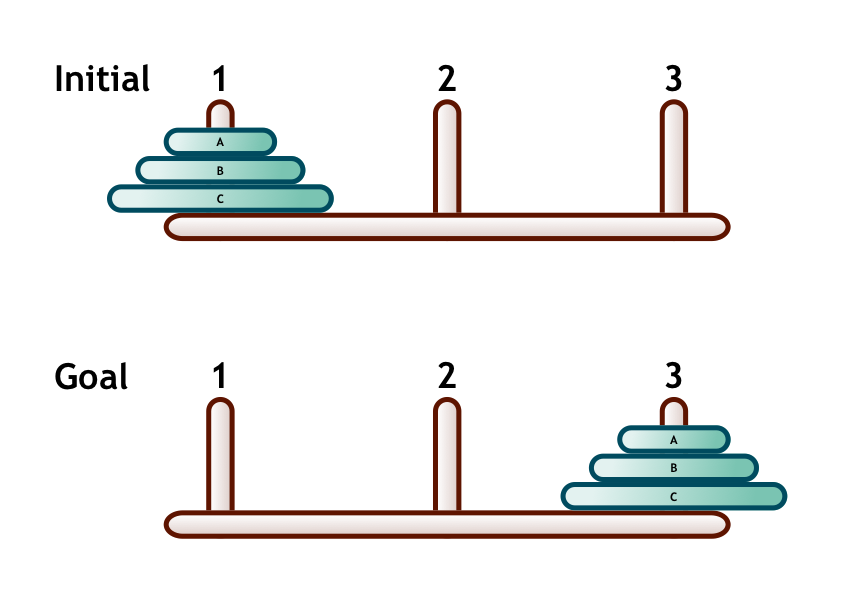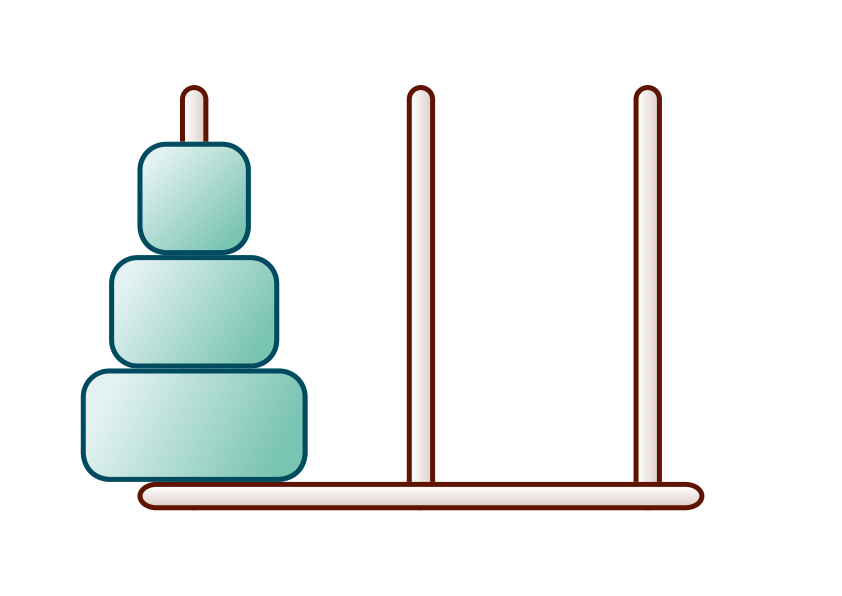The Towers of Hanoi is a classic mathematical puzzle that has intrigued minds since it was created in 1883 by the French mathematician Édouard Lucas. The puzzle involves three pegs and three or more discs of varying sizes that can slide onto any peg. The objective is to move the entire stack of disks from one peg to another, adhering to specific rules: only one disk can be moved at a time, a larger disk cannot be placed on top of a smaller disk, and each move has to consist of taking the upper disk from one of the stacks and placing it on top of another stack.

The problem was invented by the French mathematician Édouard Lucas in 1883. Lucas created this puzzle as a part of a story about a temple in Hanoi, the capital of Vietnam, where priests were said to be moving 64 golden disks. According to the legend, once the priests completed their task, the world would end. This dramatic backstory captured people’s imaginations!
The name comes from the story that Lucas created, which features the priests’ moving disks between towers. The “Towers” refer to the three rods, and “Hanoi” connects the puzzle to the temple in Vietnam, making it not just a mathematical challenge, but also a point of cultural interest.
At its core, the Towers of Hanoi is not just a game; it’s an illustration of recursion and algorithmic thinking. The minimum number of moves required to solve the puzzle with ‘n’ disks is given by the formula ‘2^n-1’. This exponential growth highlights the complexity of the problem as the number of disks increases, making it a fascinating study for mathematicians and computer scientists alike.
Let’s look at how to solve the Towers of Hanoi puzzle. If you have just one disk, it’s simple — just move it directly from the first rod to the third.
With two disks, you first move the smaller disk to the second rod, then move the larger disk to the third rod, and finally place the smaller disk on top of the larger disk.
So how do you solve it when you have more disks? The solution involves a method called recursion, where you solve smaller instances of the problem. You have to:
- Move the top n-1 disks from the first rod to the second rod.
- Move the nth (largest) disk to the third rod.
- Finally, move the n-1 disks from the second rod to the third rod.
The minimum number of moves required to solve the Towers of Hanoi with n disks is given by the formula 2n – 1. This means for 3 disks, you need 23 – 1 = 7 moves, and for 4 disks, it’s 24 – 1 = 15 moves. This exponential growth shows just how tricky the puzzle can get!
While the Towers of Hanoi puzzle may seem like an intellectual exercise, its principles have practical applications in various fields:
1. Computer Science and Algorithm Design: The recursive nature of the Towers of Hanoi puzzle is a prime example used in teaching algorithms. It serves as an introductory problem in data structures and recursion, helping students in understanding how functions can repeat themselves to solve problems.
2. Data Storage and Retrieval: In computer science, the puzzle’s principles can be applied to understand the mechanics of data storage. For instance, when transferring data between storage devices, similar rules of organization and retrieval can be observed. The management of data involved in this process can often be compared to solving a Towers of Hanoi scenario.
3. Operations Research: The puzzle can also model complex logistical problems where items need to be moved from one location to another while adhering to specific constraints. For example, in warehouse management, where boxes of different sizes need to be organized for optimal retrieval and shipping, the strategies derived from the Towers of Hanoi can offer an alternative (slightly wacky) way of approaching the problem.
4. Robotics: In robotics, the principles of the Towers of Hanoi can be applied to teach robots how to perform tasks that require sequential movements. By programming robots to execute moves equivalent to those in the puzzle, developers can improve their efficiency in tasks such as assembly line operations.
5. Game Theory and Mathematical Strategy: The Towers of Hanoi serves as a model for studying strategic decision-making. It offers lessons in planning and foresight, applicable in business and economics, where stakeholders must anticipate the outcomes of their actions.
The Towers of Hanoi puzzle is more than just a stimulating brain teaser; it encapsulates essential concepts in mathematics, computer science, and operations research. Its real-world applications stretch across various industries, showcasing the relevance of mathematical thought in everyday problem-solving. By embracing the challenges presented by the Towers of Hanoi, individuals can sharpen their analytical skills and appreciate the beauty of mathematics in action. People have even created giant Towers of Hanoi puzzles as games in parks and playgrounds!
